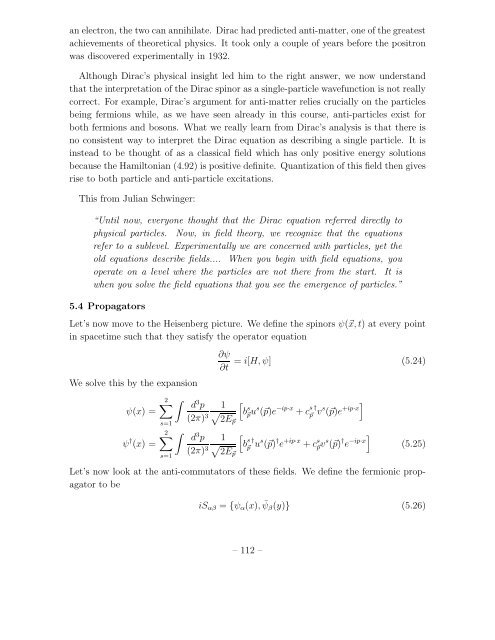Quantum Field Theory
Quantum Field Theory
Quantum Field Theory
Create successful ePaper yourself
Turn your PDF publications into a flip-book with our unique Google optimized e-Paper software.
an electron, the two can annihilate. Dirac had predicted anti-matter, one of the greatestachievements of theoretical physics. It took only a couple of years before the positronwas discovered experimentally in 1932.Although Dirac’s physical insight led him to the right answer, we now understandthat the interpretation of the Dirac spinor as a single-particle wavefunction is not reallycorrect. For example, Dirac’s argument for anti-matter relies crucially on the particlesbeing fermions while, as we have seen already in this course, anti-particles exist forboth fermions and bosons. What we really learn from Dirac’s analysis is that there isno consistent way to interpret the Dirac equation as describing a single particle. It isinstead to be thought of as a classical field which has only positive energy solutionsbecause the Hamiltonian (4.92) is positive definite. Quantization of this field then givesrise to both particle and anti-particle excitations.This from Julian Schwinger:“Until now, everyone thought that the Dirac equation referred directly tophysical particles. Now, in field theory, we recognize that the equationsrefer to a sublevel. Experimentally we are concerned with particles, yet theold equations describe fields.... When you begin with field equations, youoperate on a level where the particles are not there from the start. It iswhen you solve the field equations that you see the emergence of particles.”5.4 PropagatorsLet’s now move to the Heisenberg picture. We define the spinors ψ(⃗x, t) at every pointin spacetime such that they satisfy the operator equationWe solve this by the expansionψ(x) =ψ † (x) =2∑∫s=12∑∫s=1∂ψ∂t= i[H, ψ] (5.24)d 3 p 1[]√ b s(2π) 3 ⃗p us (⃗p)e −ip·x + c s †⃗p vs (⃗p)e +ip·x2E⃗pd 3 p 1[]√ b s †(2π) 3 ⃗p us (⃗p) † e +ip·x + c s ⃗p vs (⃗p) † e −ip·x2E⃗p(5.25)Let’s now look at the anti-commutators of these fields. We define the fermionic propagatorto beiS αβ = {ψ α (x), ¯ψ β (y)} (5.26)– 112 –
















